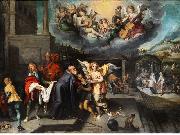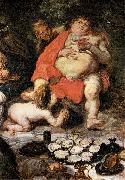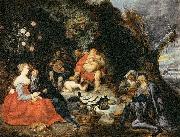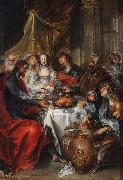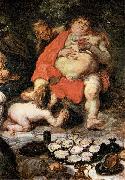Simon de Vos Oil Painting ReproductionAll Simon de Vos Oil PaintingsSimon de Vos (Antwerp, 20 October 1603-15 October 1676, Antwerp) was a Flemish Baroque painter of genre and cabinet pictures. De Vos studied with Cornelis de Vos (1603-76), to whom he is not related, from 1615 until 1620. In 1620 he joined Antwerp's guild of St. Luke, and then he probably travelled to Rome where he came under the influence of the "low-life" genre paintings of the Bentvueghels and the bambocciate. A Caravaggesque influence, by way of the German painter Johann Liss active in Italy during the 1620s is discernible in De Vos's paintings from this time on. In contrast to the earlier "low-life" paintings, works from the late 1620s until around 1640, which were made after returning to Antwerp, are mostly small "merry company" and courtly genre scenes reminiscent of contemporary Dutch painters Dirck Hals and Pieter Codde. After 1640, De Vos turned away from genre scenes altogether and painted mostly small cabinet paintings of history subjects, influenced stylistically at first by Peter Paul Rubens and then increasingly by Anthony van Dyck. Examples include The Beheading of St. Paul (1648) in the Royal Museum of Fine Arts, Antwerp. He married Catharina van Utrecht, the sister of Adriaen van Utrecht, in 1628. |
|||

|
|||
|
|
|||
|
||||||||
| Simon de Vos Simon de Vos (Antwerp, 20 October 1603-15 October 1676, Antwerp) was a Flemish Baroque painter of genre and cabinet pictures. De Vos studied with Cornelis de Vos (1603-76), to whom he is not related, from 1615 until 1620. In 1620 he joined Antwerp's guild of St. Luke, and then he probably travelled to Rome where he came under the influence of the "low-life" genre paintings of the Bentvueghels and the bambocciate. A Caravaggesque influence, by way of the German painter Johann Liss active in Italy during the 1620s is discernible in De Vos's paintings from this time on. In contrast to the earlier "low-life" paintings, works from the late 1620s until around 1640, which were made after returning to Antwerp, are mostly small "merry company" and courtly genre scenes reminiscent of contemporary Dutch painters Dirck Hals and Pieter Codde. After 1640, De Vos turned away from genre scenes altogether and painted mostly small cabinet paintings of history subjects, influenced stylistically at first by Peter Paul Rubens and then increasingly by Anthony van Dyck. Examples include The Beheading of St. Paul (1648) in the Royal Museum of Fine Arts, Antwerp. He married Catharina van Utrecht, the sister of Adriaen van Utrecht, in 1628. |
||||||||
|
|
||||||||
| Gemälde IDENTIFIZIERUNG:: 81526 Heimkehr des verlorenen Sohnes Öl auf Kupferplatte. 58,5 x 78 cm Date 1641(1641) cyf |
||||||||
|
|
||||||||
| Gemälde IDENTIFIZIERUNG:: 85781 Allegorical Scene Date 1635(1635) Medium Oil on oak cjr |
||||||||
|
|
||||||||
| Gemälde IDENTIFIZIERUNG:: 86607 Allegorical Scene Date 1635(1635) Medium Oil on oak Dimensions Height: 49 cm (19.3 in). Width: 64 cm (25.2 in). cjr |
||||||||
|
|
||||||||
| Gemälde IDENTIFIZIERUNG:: 89950 The Wedding at Cana. First half of the 17th century Medium oil on copper Dimensions 64.5 x 48.5 cm (25.4 x 19.1 in) cjr |
||||||||
|
|
||||||||
| Gemälde IDENTIFIZIERUNG:: 89977 Allegorical Scene 1635(1635) Medium oil on oak cyf |
||||||||
|
|
||||||||
| VORHERIGER KÜNSTLER NÄCHSTER KÜNSTLER | ||||||||
|
|
||||||||
|
Simon de Vos Simon de Vos (Antwerp, 20 October 1603-15 October 1676, Antwerp) was a Flemish Baroque painter of genre and cabinet pictures. De Vos studied with Cornelis de Vos (1603-76), to whom he is not related, from 1615 until 1620. In 1620 he joined Antwerp's guild of St. Luke, and then he probably travelled to Rome where he came under the influence of the "low-life" genre paintings of the Bentvueghels and the bambocciate. A Caravaggesque influence, by way of the German painter Johann Liss active in Italy during the 1620s is discernible in De Vos's paintings from this time on. In contrast to the earlier "low-life" paintings, works from the late 1620s until around 1640, which were made after returning to Antwerp, are mostly small "merry company" and courtly genre scenes reminiscent of contemporary Dutch painters Dirck Hals and Pieter Codde. After 1640, De Vos turned away from genre scenes altogether and painted mostly small cabinet paintings of history subjects, influenced stylistically at first by Peter Paul Rubens and then increasingly by Anthony van Dyck. Examples include The Beheading of St. Paul (1648) in the Royal Museum of Fine Arts, Antwerp. He married Catharina van Utrecht, the sister of Adriaen van Utrecht, in 1628. |
||||||||
|
|
||||||||
|
KONTAKTIEREN Sie UNS |





